IEC60870-5-101规约说明资料
- 格式:doc
- 大小:278.50 KB
- 文档页数:31
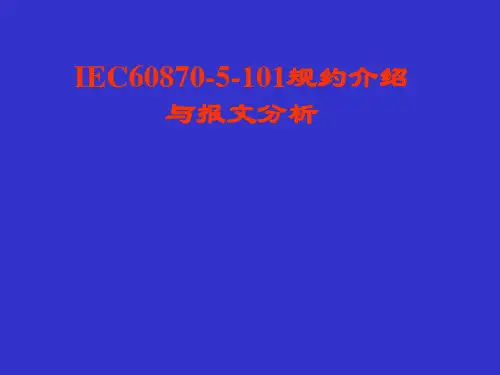
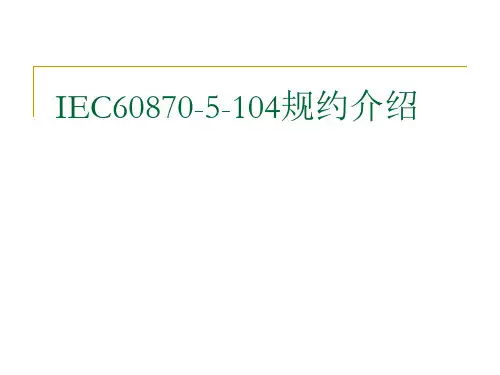
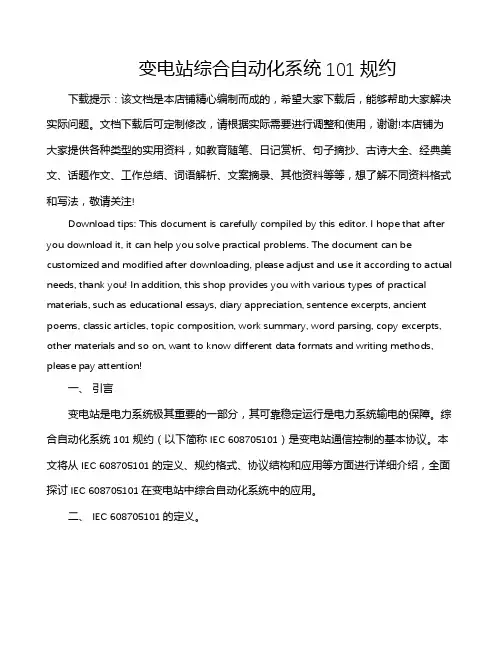
变电站综合自动化系统101规约下载提示:该文档是本店铺精心编制而成的,希望大家下载后,能够帮助大家解决实际问题。
文档下载后可定制修改,请根据实际需要进行调整和使用,谢谢!本店铺为大家提供各种类型的实用资料,如教育随笔、日记赏析、句子摘抄、古诗大全、经典美文、话题作文、工作总结、词语解析、文案摘录、其他资料等等,想了解不同资料格式和写法,敬请关注!Download tips: This document is carefully compiled by this editor. I hope that after you download it, it can help you solve practical problems. The document can be customized and modified after downloading, please adjust and use it according to actual needs, thank you! In addition, this shop provides you with various types of practical materials, such as educational essays, diary appreciation, sentence excerpts, ancient poems, classic articles, topic composition, work summary, word parsing, copy excerpts, other materials and so on, want to know different data formats and writing methods, please pay attention!一、引言变电站是电力系统极其重要的一部分,其可靠稳定运行是电力系统输电的保障。
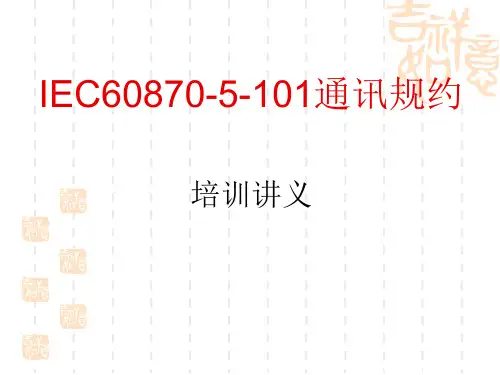
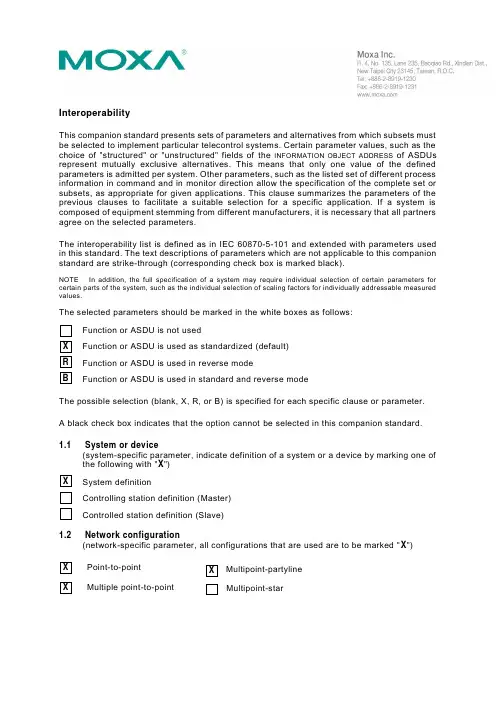
InteroperabilityThis companion standard presents sets of parameters and alternatives from which subsets must be selected to implement particular telecontrol systems. Certain parameter values, such as the choice of "structured" or "unstructured" fields of the INFORMATION OBJECT ADDRESS of ASDUs represent mutually exclusive alternatives. This means that only one value of the defined parameters is admitted per system. Other parameters, such as the listed set of different process information in command and in monitor direction allow the specification of the complete set or subsets, as appropriate for given applications. This clause summarizes the parameters of the previous clauses to facilitate a suitable selection for a specific application. If a system is composed of equipment stemming from different manufacturers, it is necessary that all partners agree on the selected parameters.The interoperability list is defined as in IEC 60870-5-101 and extended with parameters used in this standard. The text descriptions of parameters which are not applicable to this companion standard are strike-through (corresponding check box is marked black).NOTE In addition, the full specification of a system may require individual selection of certain parameters for certain parts of the system, such as the individual selection of scaling factors for individually addressable measured values.The selected parameters should be marked in the white boxes as follows:Function or ASDU is not usedFunction or ASDU is used as standardized (default) Function or ASDU is used in reverse modeFunction or ASDU is used in standard and reverse modeThe possible selection (blank, X, R, or B) is specified for each specific clause or parameter.A black check box indicates that the option cannot be selected in this companion standard. 1.1 System or device(system-specific parameter, indicate definition of a system or a device by marking one of the following with "X ")System definitionControlling station definition (Master)Controlled station definition (Slave)1.2 Network configuration(network-specific parameter, all configurations that are used are to be marked "X ") Point-to-point Multiple point-to-pointMultipoint-partyline Multipoint-starX R BX1.3 Physical layer(network-specific parameter, all interfaces and data rates that are used are to be marked "X ")Transmission speed (control direction)Unbalanced interchange Unbalanced interchange Balanced interchange Circuit V.24/V.28 Circuit V.24/V.28 Circuit X.24/X.27 Standard Recommended if >1 200 bit/sTransmission speed (monitor direction)Unbalanced interchange Unbalanced interchangeBalanced interchange Circuit V.24/V.28 Circuit V.24/V.28Circuit X.24/X.27 Standard Recommended if >1 200 bit/s1.4Link layer(network-specific parameter, all options that are used are to be marked "X". Specify themaximum frame length. Ifa non-standard assignment of class2 messages is implemented for unbalanced transmission, indicate the Type ID and COT of all messagesassigned to class 2.)Frame format FT 1.2, single character 1 and the fixed time out interval are used exclusively inthis companion standard.100 bit/s 200 bit/s 300 bit/s 600 bit/s1 200 bit/s2 400 bit/s 4 800 bit/s 9 600 bit/s 2 400 bit/s 4 800 bit/s 9 600 bit/s 19 200 bit/s 38 400 bit/s 100 bit/s 200 bit/s 300 bit/s 600 bit/s 1 200 bit/s 2 400 bit/s 4 800 bit/s 9 600 bit/s 2 400 bit/s 4 800 bit/s 9 600 bit/s 19 200 bit/s 38 400 bit/s 56 000 bit/s 64 000 bit/s Balanced transmission Unbalanced transmissionNot present (balanced transmission only) One octet Two octets Structured UnstructuredWhen usingan unbalanced link layer,the followingASDU types arereturned in class 2 messages (low priority) with the indicated causes of transmission:Note: (In response to a class 2 poll, a controlled station may respond with class 1 data when there is no class 2 data available).1.5 Application layerTransmission mode for application dataMode 1 (Least significant octet first), as defined in 4.10 of IEC 60870-5-4, is used exclusively in this companion standard.Common address of ASDU(system-specific parameter, all configurations that are used are to be marked "X")Information object address(system-specific parameter, all configurations that are used are to be marked "X")Cause of transmission(system-specific parameter, all configurations that are used are to be marked "X") One octet Two octetsOne octet StructuredTwo octetsoctetsUnstructuredThree octetsOne octet Two octets (with originatoraddress). Originator addressis set to zero if not usedThe standard assignment of ASDUs to class 2 messages is used as follows:A special assignment of ASDUs to class 2 messages is used as follows:Selection of standard ASDUsProcess information in monitor direction(station-specific parameter, mark each Type ID "X " if it is only used in the standard direction, "R " if only used in the reverse direction, and "B " if used in both directions).– <40> for ASDUs with time tag is permitted .<1> := Single-point information M_SP_NA_1 <30> := Single-point information with time tag CP56Time2a M_SP_TB_1 <31> := Double-point information with time tag CP56Time2a M_DP_TB_1 <32> := Step position information with time tag CP56Time2a M_ST_TB_1 <33> := Bitstring of 32 bit with time tag CP56Time2aM_BO_TB_1 <34> := Measured value, normalized value with time tag CP56Time2a M_ME_TD_1 <35> := Measured value, scaled value with time tag CP56Time2aM_ME_TE_1 <36> := Measured value, short floating point value with time tag CP56Time2aM_ME_TF_1 <37> := Integrated totals with time tag CP56Time2aM_IT_TB_1 <38> := Event of protection equipment with time tag CP56Time2aM_EP_TD_1<39> := Packed start events of protection equipment with time tag CP56Time2aM_EP_TE_1 <40> := Packed output circuit information of protection equipment with time tag CP56Time2a M_EP_TF_1<2> := Single-point information with time tag M_SP_TA_1 <3> := Double-point informationM_DP_NA_1 <4> := Double-point information with time tag M_DP_TA_1 <5> := Step position informationM_ST_NA_1 <6> := Step position information with time tag M_ST_TA_1 <7> := Bitstring of 32 bitM_BO_NA_1 <8> := Bitstring of 32 bit with time tag M_BO_TA_1 <9> := Measured value, normalized valueM_ME_NA_1 <10> := Measured value, normalized value with time tag M_ME_TA_1 <11> := Measured value, scaled valueM_ME_NB_1 <12> :=Measured value, scaled value with time tagM_ME_TB_1 <13> := Measured value, short floating point valueM_ME_NC_1 <14> := Measured value, short floating point value with time tag M_ME_TC_1 <15> := Integrated totalsM_IT_NA_1 <16> := Integrated totals with time tag M_IT_TA_1 <17> := Event of protection equipment with time tagM_EP_TA_1 <18> := Packed start events of protection equipment with time tagM_EP_TB_1 <19> := Packed output circuit information of protection equipment with time tag M_EP_TC_1 <20> := Packed single-point information with status change detectionM_SP_NA_1 <21> := Measured value, normalized value without quality descriptor M_ME_ND_1Process information in control direction(station-specific parameter, mark each Type ID "X " if it is only used in the standard direction, "R " if only used in the reverse direction, and "B " if used in both directions).System information in monitor direction(station-specific parameter, mark withan “X ” if it is onlyused in the standard direction, “R ” if only used in the reverse direction, and “B ” if used in both directions).System information in control direction(station-specific parameter, mark each Type ID "X " if it is only used in the standard direction, "R " if only used in the reverse direction, and "B " if used in both directions).<45> := Single commandC_SC_NA_1 <46> := Double command C_DC_NA_1 <47> := Regulating step commandC_RC_NA_1 <48> := Set point command, normalized value C_SE_NA_1 <49> := Set point command, scaled valueC_SE_NB_1 <50> := Set point command, short floating point value C_SE_NC_1 <51> := Bitstring of 32 bitC_BO_NA_1<70> := End of initialization M_EI_NA_1 <100>:= Interrogation commandC_IC_NA_1 <101>:= Counter interrogation commandC_CI_NA_1 <102>:= Read command C_RD_NA_1 <103>:= Clock synchronization command (option see 7.6) C_CS_NA_1 <104>:= Test command C_TS_NA_1 <105>:= Reset process command C_RP_NA_1 <106>:= Delay acquisition commandC_CD_NA_1 <107>:= Test command with time tag CP56Time2a C_TS_TA_1Parameter in control direction(station-specific parameter, mark each Type ID "X " if it is only used in the standard direction, "R " if only used in the reverse direction, and "B " if used in both directions).File transfer(station-specific parameter, mark each Type ID "X " if it is only used in the standard direction, "R " if only used in the reverse direction, and "B " if used in both directions).Type identifier and cause of transmission assignments (station-specific parameters)Shaded boxes are not defined in this companion standard and shall not be used. Black boxes: option not permitted in this companion standard Blank: functions or ASDU not used.Mark Type Identification/Cause of transmission combinations: "X " if only used in the standard direction; "R " if only used in the reverse direction; "B " if used in both directions.<110>:= Parameter of measured value, normalized valueP_ME_NA_1 <111>:= Parameter of measured value, scaled valueP_ME_NB_1 <112>:= Parameter of measured value, short floating point value P_ME_NC_1 <113>:= Parameter activationP_AC_NA_11.6 Basic application functionsStation initialization(station-specific parameter, mark "X " if function is used)Remote initializationCyclic data transmission(station-specific parameter,mark "X " iffunction is only usedin the standard direction, "R" if only used in the reverse direction, and "B " if used in both directions)Cyclic data transmissionRead procedure(station-specific parameter, mark "X " if function is only used in the standard direction, "R " if only used in the reverse direction, and "B " if used in both directions) Read procedureSpontaneous transmission(station-specific parameter, mark "X " if function is only used in the standard direction, "R " if only used in the reverse direction, and "B " if used in both directions) Spontaneous transmissionDouble transmission of information objects with cause of transmission spontaneous(station-specific parameter, mark each information type "X " where both a Type ID without time and corresponding Type ID with time are issued in response to a single spontaneous change of a monitored object)The following type identifications may be transmitted in succession caused by a single status change of an information object. The particular information object addresses for which double transmission is enabled are defined in a project-specific list. Single-point information M_SP_NA_1, M_SP_TA_1, M_SP_TB_1 and M_PS_NA_1 Double-point information M_DP_NA_1, M_DP_TA_1 and M_DP_TB_1 Step position information M_ST_NA_1, M_ST_TA_1 and M_ST_TB_1Bitstring of 32 bit M_BO_NA_1, M_BO_TA_1 and M_BO_TB_1 (if defined for a specific project) Measured value, normalized value M_ME_NA_1, M_ME_TA_1, M_ME_ND_1 and M_ME_TD_1Measured value, scaled value M_ME_NB_1, M_ME_TB_1 and M_ME_TE_1Measured value, short floating point number M_ME_NC_1, M_ME_TC_1 and M_ME_TF_1Station interrogation(station-specific parameter, mark "X " if function is only used in the standard direction, "R " if only used in the reverse direction, and "B " if used in both directions).Clock synchronization(station-specificparameter, mark"X "if function isonly used inthe standard direction,"R " ifonly used in the reverse direction, and "B" if used in both directions).optional, see 7.6Command transmission(object-specific parameter, mark "X " if function is only used in the standard direction, "R " if only used in the reverse direction, and "B " if used in both directions).global group 7 group 13 group 1 group 8 group 14 group 2 group 9 group 15 group 3 group 10 group 16group 4 group 11 group 5 group 12group 6 Information object addresses assigned to each group must be shown in a separate table.Clock synchronization Direct command transmission Direct set point command transmission Select and execute commandSelect and execute set point command C_SE ACTTERM used No additional definitionShort-pulse duration (duration determined by a system parameter in the outstation) Persistent output Long-pulse duration (duration determined by a system parameter in the outstation)Day of week used RES1, GEN (time tag substituted/ not substituted) used SU-bit (summertime) usedTransmission of integrated totals(station- or object-specific parameter, mark "X " if function is only used in the standard direction, "R " if only used in the reverse direction, and "B " if used in both directions).Parameter loading(object-specific parameter, mark "X " if function is only used in the standard direction, "R " if only used in the reverse direction, and "B " if used in both directions).Parameter activation(object-specific parameter, mark "X " if function is only used in the standard direction, "R " if only used in the reverse direction, and "B " if used in both directions).Test procedure(station-specific parameter, mark "X " if function is only used in the standard direction, "R " if only used in the reverse direction, and "B " if used in both directions).Counter readCounter freeze without reset Counter freeze with reset Counter resetGeneral request counter Request counter group 1 Request counter group 3Request counter group 2 Request counter group 4 Threshold value Smoothing factorLow limit for transmission of measured values High limit for transmission of measured valuesAct/deact of persistent cyclic or periodic transmission of the addressed objectMode A: Local freeze with spontaneous transmission Mode B: Local freeze with counter interrogationMode C: Freeze and transmit by counter-interrogation commandsMode D: Freeze by counter-interrogation command, frozen values reported spontaneously Test procedureFile transfer(station-specific parameter, mark "X " if function is used).File transfer in monitor directionFile transfer in control directionBackground scan(station-specific parameter, mark "X " if function is only used in the standard direction, "R " if only used in the reverse direction, and "B " if used in both directions).Acquisition of transmission delay(station-specific parameter, mark "X " if function is only used in the standard direction, "R " if only used in the reverse direction, and "B " if used in both directions).Transparent fileBackground scan Acquisition of transmission delay Transparent fileTransmission of disturbance data of protection equipment Transmission of sequences of events Transmission of sequences of recorded analogue values。
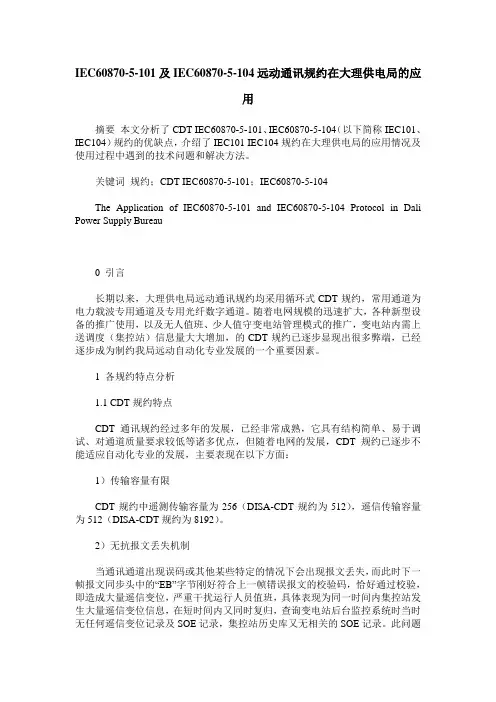
IEC60870-5-101及IEC60870-5-104远动通讯规约在大理供电局的应用摘要本文分析了CDT IEC60870-5-101、IEC60870-5-104(以下简称IEC101、IEC104)规约的优缺点,介绍了IEC101 IEC104规约在大理供电局的应用情况及使用过程中遇到的技术问题和解决方法。
关键词规约;CDT IEC60870-5-101;IEC60870-5-104The Application of IEC60870-5-101 and IEC60870-5-104 Protocol in Dali Power Supply Bureau0 引言长期以来,大理供电局远动通讯规约均采用循环式CDT规约,常用通道为电力载波专用通道及专用光纤数字通道。
随着电网规模的迅速扩大,各种新型设备的推广使用,以及无人值班、少人值守变电站管理模式的推广,变电站内需上送调度(集控站)信息量大大增加,的CDT规约已逐步显现出很多弊端,已经逐步成为制约我局远动自动化专业发展的一个重要因素。
1 各规约特点分析1.1 CDT规约特点CDT通讯规约经过多年的发展,已经非常成熟,它具有结构简单、易于调试、对通道质量要求较低等诸多优点,但随着电网的发展,CDT规约已逐步不能适应自动化专业的发展,主要表现在以下方面:1)传输容量有限CDT规约中遥测传输容量为256(DISA-CDT规约为512),遥信传输容量为512(DISA-CDT规约为8192)。
2)无抗报文丢失机制当通讯通道出现误码或其他某些特定的情况下会出现报文丢失,而此时下一帧报文同步头中的“EB”字节刚好符合上一帧错误报文的校验码,恰好通过校验,即造成大量遥信变位,严重干扰运行人员值班,具体表现为同一时间内集控站发生大量遥信变位信息,在短时间内又同时复归,查询变电站后台监控系统时当时无任何遥信变位记录及SOE记录,集控站历史库又无相关的SOE记录。

IEC-60870-5-101规约解析概述摘要:IEC-60870-5-101规约是调度端与场站端进行信息交互的一种规约,为国际电工委员会(IEC)在1995年制定,并于2001年将95版规约扩充,制定2002版即现行国内各主流调度、子站厂商全面应用的版本。
鉴于IEC-60870-5-101其在电力系统远动通讯规约的主导地位已经确立并且220kV电压等级风电场均已通过101规约将站内信息上送调度,本文将对如何解析IEC-60870-5-101报文进行阐述。
关键词:IEC-60870-5-101规约解析1规约总述IEC-60870-5-101规约是一种问答式规约,即你问我答、不问不答模式。
它有两种传输方式:平衡式传输和非平衡式传输。
平衡式传输中101规约是一种“问答+循环”式规约,即主站和子站都可以启动报文传输。
而当其用非平衡式传输时,只有主站端能启动报文传输。
101规约的报文在传输时,采用固定帧长和可变帧长及单个控制字符方式。
2 IEC101报文的帧格式2.1固定帧长帧格式固定帧长帧由5~6个字节组成,链路地址域可为一个或两个字节。
用于主站向子站的询问报文或者子站回答主站的确认报文。
具体格式如下表:报文示例: 10 5B 01 5C 16解析为请求二级用户数据,其中10为启动字符,5B为控制域,01为链路层地址,5C为检验和,16为结束字符。
2.2 可变帧长帧格式可变帧长用于主站向子站传输数据或子站向主站传输数据,具体格式如下表:表2 可变帧长帧格式报文示例:68 09 09 68 53 40 64 01 06 01 00 00 14 13 16其中68 09 09 68按上表解析为报文头,53为控制域字节,40为链路层地址转换为10进制为64,64为总召唤类型标识,01为可变结构限定词,06为传输原因,01为公共地址,00 00为信息体地址,14为信息体元素,13为帧校验和,16为结束字符。
3 应答过程就像规定了人说一句话第一个词说什么含义是什么一样,101报文的帧格式规定了报文中各个字符的定义和功能。
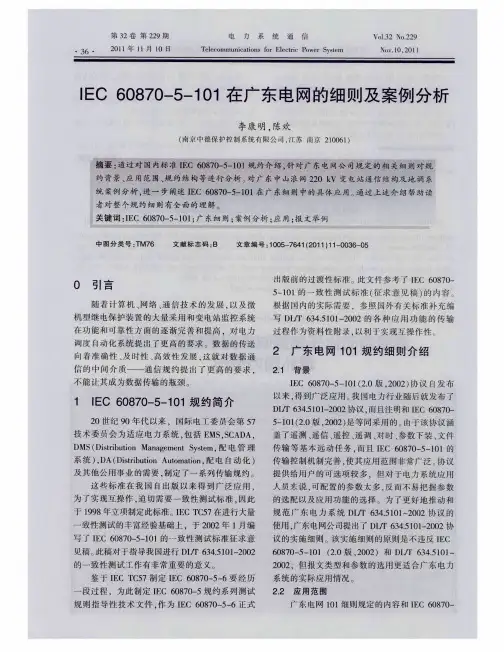
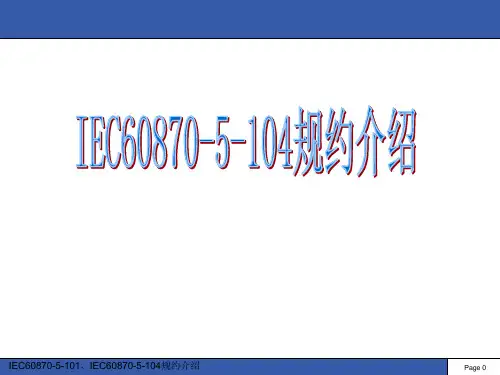
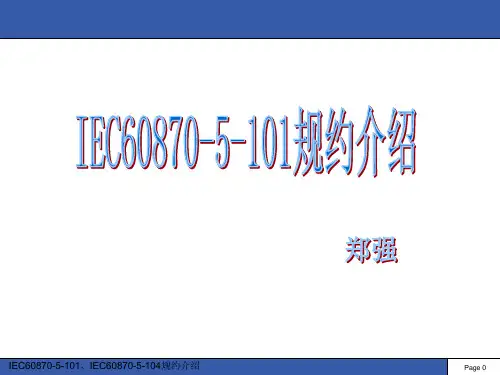

101规约说明书(总19页)
--本页仅作为文档封面,使用时请直接删除即可--
--内页可以根据需求调整合适字体及大小--
帧检验和是控制、地址、用户数据区所有字节的算术和(不考虑溢出位即256模和)。
3.平衡式传输(主站作为启动站的各种报文)
主站的询问顺序
主站请求链路状态→子站响应链路状态→主站复位远方链路→子站肯定确认
子站请求链路状态→主站响应链路状态→子站复位远方链路→主站肯定确认
链路过程若失败则重发3次,3次后停止通讯并置链路为断开状态。
主站的工作流程是主站总召唤→时间同步→召唤1级用户数据→进行遥控→时间同步→召唤2级用户数据→召唤分组YX→召唤分组YC
子站故障主动上传→主站肯定确认
复位远方链路报文
主站复位远方链路帧(C_RL_NA_1)
主站召唤1级用户数据发送帧(C_P1_NA_1)
子站发送遥控命令确认帧(预置/执行)(C_DC_NA_1)
主站发送遥控撤消命令帧(C_DC_NA_1 DEACT)。
IEC60870-5-101传输规约解读与报文分析王志平(江苏省电力调度通信中心,江苏省南京市210024)摘要:为了使广大用户能尽快熟悉、掌握、应用IEC60870-5-101传输规约,文中对101传输规约及常用通信报文进行了解读与分析。
关键词:传输规约;报文;分析0 引言IEC60870-5-101传输规约是国际标准规约,在电力系统主要应用于RTU 与SCADA 系统之间的数据通信,现在全国各省市正在推广应用,江苏省调于2001年开始应用,目前已有28个直收厂站实现了101规约的通信,为了帮助广大用户更快地了解规约的传输格式,能看懂和分析报文,本文对101传输规约的工作原理及常用报文内容进行解读与分析。
1 工作流程工作流程如图1所示。
图中,突发数据是指遥信状态变位信息、遥测越死区值数据,突发数据定义为一级数据,立即传输。
总召唤是指初始化后或者通信中断超过规定的时间后主站发总召唤命令,召唤厂站全数据,定义为一级数据。
控制命令有开关、刀闸遥控操作命令、AGC 控制调节命令等。
2 传输帧格式与报文分析传输帧格式有三种:固定帧格式、可变帧格式及单字节。
固定帧格式以10开头16结束,主要用于链路层的服务。
可变帧格式以68开头16结束,主要用于控制站与被控制站之间的数据交换。
单字节E5通常用于确认用户数据。
2.1 固定帧格式与应用分析 2.1.1 固定帧格式(见图2)图2 固定帧格式2.1.2 初始化控制站电源重启或通信中断超过规定的时间后都要进行初始化。
其初始化报启始字10控制域链路地址校验和结束字16初始化 图1 工作流程图文为:TRAN:1069016A16;RECV:100B010C16;TRAN:1040014116;RECV:1000010116。
报文分析如下:(1)报文1069016A16 中69表示信源信息位PRM=1,功能码FC=9,其作用是控制站发请求链路状态报文与被控制站重新建立链路。
I 格式帧报文格式:起动字符68H 长度L 长度(重复)L 启动字符68H 控制域 下行0 1 FCB FCV 23 22 21 20 上行 PRM ACD DFC 功能码 链路单元地址 单元地址 类型标识1,9,30,45,46,47,100,101,103,104 可变结构限定词SQ 数目 传送原因3,6,7,8,9,10,14 公共地址与链路单元地址相同 信息对象地址01H 40H 信息元素集 ……信息对象时标(CP56Time2a或CP24Time2a ) 毫秒L毫秒H 分 时 日月年信息对象n…… 校验和CS 尾字符 16H/* 召唤链路状态 */10 69 0b 74 1610 2b 0b 36 16/* 复位链路单元 */10 40 0b 4b 1610 00 0b 0b 16/* 同步对时 */68 0f 0f 68 53 0b 67 01 06 0b 00 00 67 5a 3a 0f 0b 07 08 fb 16 | | | | | | | | |-----| |--------------------------| |长度 长度 控制域 | 类型 | 原因 | 对象地址 CP56Time2a 时标 校验和地址 限定词 公共地址 毫秒L-毫秒H-分-时-日-月-年10 20 0b 2b 16/* 请求一级数据 */10 7a 0b 85 1668 0f 0f 68 08 0b 67 01 07 0b 00 00 67 5a 3a 0f 0b 07 08 b1 16/* 总召 */报文头 ASDU长度 数据单元标识符68 09 09 68 73 0b 64 01 06 0b 00 00 14 08 1610 20 0b 2b 16/* 请求一级数据 */10 5a 0b 65 1668 09 09 68 28 0b 64 01 07 0b 00 00 14 BE 16 /* 总召激活帧 */| | | | | | | | |-----| | |长度长度控制域 | 类型 | 原因 | 对象地址 | 校验和地址限定词公共地址值/* 总召遥信帧 */10 7a 0b 85 1668 87 87 68 28 0b 01 ff 14 0b 01 00 01 00 00 00 00 00 00 00 00 00 00 00 01 01 00 01 01 00 00 00 00 00 00 00 00 00 00 00 00 00 80 00 00 00 00 00 00 00 00 00 00 00 01 01 00 01 01 00 00 00 00 00 00 00 00 00 00 00 00 00 80 00 00 00 00 00 00 00 00 00 00 00 01 01 00 01 01 00 00 00 00 00 00 00 00 00 00 00 00 00 80 00 00 00 00 00 00 00 00 00 00 00 01 01 01 00 01 00 00 00 00 00 00 00 00 00 00 00 00 00 80 00 00 00 00 00 00 64 16/* 总召遥测帧 */10 5a 0b 65 1668 c8 c8 68 28 0b 09 c0 14 0b 01 40 04 04 00 09 04 00 09 04 00 6a 00 00 73 00 00 90 00 00 fa 07 00 3b 00 00 fe ff 00 aa 06 00 07 04 00 06 04 00 08 04 00 1e 02 00 17 02 00 3d 02 00 26 f8 00 f0 fe 00 ca ff 00 aa 06 00 08 04 00 08 04 00 08 04 00 00 00 00 00 00 00 00 00 00 00 00 00 00 00 00 00 00 00 07 04 00 08 04 00 08 04 00 00 00 00 f8 06 00 fd 06 00 fc 06 00 1f 06 00 1a 06 00 99 03 00 83 03 00 12 05 00 3e 05 00 00 00 00 00 00 00 00 00 00 00 00 00 00 00 00 6c 05 00 6d 05 00 49 05 00 4c 05 00 36 01 00 21 01 00 32 01 00 00 00 00 00 00 00 00 00 00 e5 03 00 e4 03 00 04 04 00 1e 00 00 d4 06 00 d5 06 00 d0 06 00 8b 1610 7a 0b 85 1668 c8 c8 68 28 0b 09 c0 14 0b 41 40 db 03 00 d0 03 00 f0 03 00 1e 00 00 b4 06 00 b6 06 00 b3 06 00 08 04 00 08 04 00 08 04 00 93 00 00 92 00 00 97 00 00 61 07 00 49 00 00 1d 00 00 e2 03 00 e3 03 00 08 04 00 fc 00 00 fd 00 00 ff 00 00 77 07 00 76 00 00 2d 00 00 08 04 00 07 04 00 08 04 00 ca 02 00 cb 02 00 ca 02 00 c1 07 00 5e 01 00 57 00 00 da 03 00 d0 03 00 f1 03 00 af 04 00 af 04 00 a4 04 00 f0 07 00 3e 02 00 47 00 00 00 00 00 00 00 00 00 00 00 00 00 00 00 00 00 00 00 00 00 00 00 00 00 00 00 00 00 00 00 00 00 00 00 00 00 00 00 00 00 00 00 00 00 00 00 00 00 00 b2 01 00 b6 01 00 bb 01 00 9a 07 00 cd 00 00 f5 1610 5a 0b 65 1668 c8 c8 68 28 0b 09 c0 14 0b 81 40 40 00 00 00 00 00 00 00 00 00 00 00 00 00 00 00 00 00 00 00 00 00 00 00 00 00 00 00 00 00 00 00 00 00 00 00 00 00 00 00 00 00 00 00 00 00 00 00 00 00 00 00 00 00 00 00 00 44 03 00 46 03 00 48 03 00 6b 07 00 77 01 00 99 00 00 e7 01 00 e8 01 00 e5 01 00 a9 07 00 e0 00 00 44 00 00 60 01 00 64 01 00 66 01 00 da 07 00 a8 00 00 1f 00 00 47 02 00 46 02 00 36 02 00 9e 07 00 07 01 00 51 00 00 37 02 00 3a 02 00 29 02 00 9a 07 00 06 01 0056 00 00 1d 03 00 23 03 00 26 03 00 b3 07 00 73 01 00 69 00 00 31 00 00 38 00 00 2b 00 00 b1 ff 00 00 00 00 18 00 00 00 00 00 00 00 00 00 00 00 a1 1610 7a 0b 85 1668 c5 c5 68 28 0b 09 bf 14 0b c1 40 00 00 00 00 00 00 00 00 00 00 00 00 00 00 00 00 00 00 00 00 00 00 00 00 00 00 00 24 02 00 2e 02 00 2c 02 00 4c 07 00 f8 00 00 6f 00 00 00 00 00 00 00 00 00 00 00 00 00 00 00 00 00 00 00 00 00 00 00 00 00 00 00 00 00 00 00 00 00 00 00 00 00 00 00 00 00 00 00 00 00 00 00 00 00 00 00 00 00 00 00 00 00 00 00 00 00 00 00 00 00 00 00 00 00 00 00 00 00 00 00 00 00 00 00 00 00 00 00 00 00 00 00 00 00 00 00 00 b4 00 00 b1 00 00 b7 00 00 96 07 00 56 00 00 1b 00 00 00 02 00 fd 01 00 fe 01 00 51 07 00 e0 00 00 64 00 00 14 00 00 14 00 00 12 00 00 24 06 00 09 00 00 06 00 00 91 16/* 总召激活终止帧 */10 5a 0b 65 1668 09 09 68 08 0b 64 01 0a 0b 00 00 14 a1 16/* 请求二级数据 */10 7b 0b 86 16E510 5b 0b 66 1610 20 0b 2b 16/* 变位遥信帧 */10 7a 0b 85 1668 09 09 68 08 0b 01 01 03 0b 27 03 00 4d 16| | | | | | | | |-----| | |长度长度控制域 | 类型 | 原因 | 对象地址 | 校验和地址限定词公共地址值/* SOE事件 */10 5b 0b 66 1668 10 10 68 08 0b 1e 01 03 0b 27 03 00 14 64 3a 0f 0b 07 08 45 16| | | | | | | | |-----| | |------------------------| | 长度长度控制域 | 类型 | 原因 | 对象地址 | CP56Time2a时标校验和地址限定词公共地址值毫秒L-毫秒H-分-时-日-月-年/* 变化遥测帧 */10 7b 0b 86 1668 a6 a6 68 08 0b 09 20 03 0b 04 40 6f 00 00 05 40 79 00 00 06 40 95 00 00 10 40 38 02 00 13 40 cf ff 00 26 40 1f 06 00 34 40 2e 01 00 4b 40 98 00 00 4c 40 98 00 00 4e 40 5b 07 00 5e 40 c5 02 00 7c 40 ab 01 00 7d 40 ae 01 00 7e 40 b3 01 00 80 40 c6 00 00 94 40 2f 03 00 95 40 38 03 00 96 40 39 03 00 98 40 71 01 00 99 40 93 00 00 9b 40 e1 01 00 9c 40 df 01 00 a0 40 5a 01 00 a6 40 41 02 00 a7 40 3e 02 00 a8 40 2d 02 00 ac 40 3d 02 00 ae 40 2f 02 00 af 40 94 07 00 b4 40 2b 03 00 b6 40 7c 01 00 b9 40 3f 00 00 71 16/* 请求二级数据 */10 5b 0b 66 16E5/* 变化遥测帧 */10 7b 0b 86 1668 5b 5b 68 08 0b 09 11 03 0b b9 40 57 00 00 ba 40 4a 00 00 bb 40 90 fc 00 bc 40 f5 ff 00 bd 40 24 00 00 cb 40 22 02 00 cc 40 26 02 00 cd 40 51 07 00 ee 40 a8 00 00 ef 40 9f 00 00 f0 40 af 00 00 f1 40 a4 07 00 f2 40 51 00 00 f5 40 f8 01 00 f6 40 f8 01 00 f7 40 4c 07 00 fd 40 b9 05 00 f3 1610 5b 0b 66 16E5。
华东101规约1概述程序参考的规约文本是《IEC 60870-5-101 华东电网工程应用细则》,由于IEC870-5-101 标准的选项较多,给予用户带来不确定因素较多,容易给各用户的理解造成偏差,在系统接口上难以降低系统的调试难度和成本。
本细则严格遵循IEC 60870-5-101(版本57/566/CDV:2002)标准、严格遵循国家电力调度通信中心颁布的《DL/T634.5101-2002/IEC60870-5-101:2002(基本远动任务配套标准)应用规范》,并结合华东电网的实际工程的需求编写,对部分内容作了细化,以便于在华东电网远动101 规约应用的统一、有序地开展。
2重要说明2.1 规约说明在该规约中所有参数字节数都是固定的,具体规定如下:1)、可变结构限定词:1个字节2)、传送原因:1个字节3)、应用服务数据单元公共地址:1个字节4)、信息对象地址:2个字节2.2 程序处理说明1)、最多支持8个串口规约2)、最大支持遥测个数为2048个3)、最大支持遥信个数为4096个4)、最大支持遥脉个数为192个5)、最大支持遥控个数为1024个6)、如果该规约参数文件huadong.par读取不成功,则使用缺省参数。
7)、背景扫描间隔为600秒,循环遥测发送间隔为120秒。
8)、程序中处理的asdu类型有:asud1、asud20、asud2、asud30、asud9、asud13、asud15、asud37、asud45、asud46、asud47、asud70、asud100、asud101、asud102、asud103、asud104、asud105、asud106、asud110。
3通讯规约设置用NscAssit通讯组态软件在所需的串口选用“华东IEC101规约”,再设置相应的串口通信参数即可,如转发表、波特率、校验方式、传输方式、遥控方式、数据位、停止位、通讯方式等。
4huadong.par参数文件设置4.1 基本参数¾站址即链路地址和ASDU地址,该值是主站分配给子站的通讯地址。
远动传输规约之IEC60870-5-101篇1)101规约唯一地采用IEC60870-5-1 6.2.4.2 中定义的帧格式FT1.2,IEC-60870-5(远动设备及系统第五部分传输规约--共五篇)下载,FT1.2三种帧结构格式如下:(固定帧长格式)(可变帧长格式)(单字节)2)101规约有平衡传输和非平衡传输两种方式:①非平衡传输方式对于信息采集、处理均由主站控制策略实现优化,实现简单,易于控制;②平衡传输可以快速上传重要信息,信息传输效率更高,主动性更强,但是主站端相应、控制较复杂。
平衡传输只能用于点对点或者多个点对点的全双工通道。
如果通道为半双工通道或多点共线、多点环形、多点星形等通道配置,只能采用非平衡传输。
101规约一般应使用非平衡方式。
3)101规约--控制域的定义:D7 D6 D5 D4 D3 D2 D1 D0①主站 --> 子站②子站 --> 主站①传输方向位DIR。
DIR=0,表示报文是由主站向子站传输。
启动报文位PRM。
PRM=1,表示主站向子站传输,主站为启动站。
帧计数位FCB。
主站向同一个子站传输新一轮的发送/确认(SEND/CONFIRM)或请求/响应(REQUEST/RESPOND)传输服务时,将FCB 位取相反值,主站为每一个子站保留一个帧计数位的拷贝,若超时没有从子站收到所期望的报文,或接收出现差错,则主站不改变帧计数位(FCB)的状态,重复传送原报文,重复次数为3 次。
若主站正确收到子站报文,则该一轮的发送/确认(SEND/CONFIRM)或请求/响应(REQUEST/RESPOND)传输服务结束。
复位命令的帧计数位常为0,帧计数有效位FCV=0。
帧计数有效位FCV:FCV=0 表示帧计数位(FCB)的变化无效。
FCV=1 表示帧计数位(FCB)的变化有效。
发送/无回答服务、重传次数为0的报文、广播报文时不需考虑报文丢失和重复传输,无需改变帧计数位(FCB)的状态,因此这些帧的计数有效位常为0。
第一章.IEC870-5-101规约说明规约标准原文请参照国内1998-05-01实施的等同标准《远动设备及系统第5部分传输规约第101篇基本远动任务配套标准》。
参考模型:本标准中使用的参考模型是源于开放式系统互联的ISO-OSI参考模型,由于远动系统在有限带宽下要求特别短的反应时间,故改进采用增强性能结构(EPA),见下图所示:在这样的参考模型下,各层次数据单元之间的关系如下图所示:帧格式:1.固定帧长帧格式2.可变帧长帧格式FT1.2的传输标准要求线路上低位先传;线路的空闲为二进制的1;两帧之间的线路空闲间隔需不小于33位;每个字符包括1位起始位、1位停止位、1位偶校验位、8位数据位,字符间无需线路空闲间隔;信息字节求和校验(Check Sum)。
其中各部分的含义如下1)长度L=C+A+链路用户数据的长度。
2)控制域C的定义如下:主站向子站传输时:DIR=0, PRM=1;子站向主站传输时:DIR=1, PRM=0。
主站向同一个子站传输新一轮的发送/确认和请求/响应传输服务时,将FCB位取反;主站为每一个子站保留一个帧计数位的拷贝,若超时没有从子站收到所期望的报文,或接收出现差错,则主站不改变帧计数位的状态,重复传送原报文,重复次数为3次。
FCV若等于0,FCB的变化无效。
主站向子站传输的功能码如下表所列:子站向主站传输的功能码如下表所列:1)链路地址域的内容指的是子站即RTU的站号,通常由调度与变电站协商确定。
2)链路用户数据(即前文所提到的ASDU)的结构如下:其中,各部分的解释如下:a.类型标识常用的有:子站-->主站过程信息1――不带时标的单点信息;2――带时标的单点信息;3――不带时标的双点信息;4――带时标的双点信息;5――步位置信息(变压器分接头信息)6――带时标的步位置信息(变压器分接头信息)(未用)7――子站远动终端状态(未用)9――测量值10――带时标的测量值(未用)15――电能脉冲计数量16――带时标的电能脉冲计数量(未用)17――带时标的继电保护或重合闸设备单个事件18――带时标的继电保护装置成组启动事件(未用)19――带时标的继电保护装置成组输出电路信息事件(未用)20――具有状态变位检出的成组单点信息21――不带品质描述的测量值22~24――为配套标准保留232――BCD码(水位值)主站 子站在控制方向的过程信息46――双点遥控命令(控单点也可)47――升降命令(未用)48――设定命令(未用)子站→主站在监视方向的系统信息70――初始化结束71~99――为配套标准保留主站→子站在控制方向的系统信息100――召唤命令101――电能脉冲召唤命令102――读数据命令(未用)103――时钟同步命令104――测试命令(未用)105――复位进程命令(未用)101~109――为配套标准保留b.可变结构限定词其结构如下:高位低位SQ=1:表明此帧中的信息体是按信息体地址顺序排列的。
第一章.IEC870-5-101规约说明规约标准原文请参照国内1998-05-01实施的等同标准《远动设备及系统第5部分传输规约第101篇基本远动任务配套标准》。
参考模型:本标准中使用的参考模型是源于开放式系统互联的ISO-OSI参考模型,由于远动系统在有限带宽下要求特别短的反应时间,故改进采用增强性能结构(EPA),见下图所示:在这样的参考模型下,各层次数据单元之间的关系如下图所示:帧格式:1.固定帧长帧格式2.可变帧长帧格式FT1.2的传输标准要求线路上低位先传;线路的空闲为二进制的1;两帧之间的线路空闲间隔需不小于33位;每个字符包括1位起始位、1位停止位、1位偶校验位、8位数据位,字符间无需线路空闲间隔;信息字节求和校验(Check Sum)。
其中各部分的含义如下1)长度L=C+A+链路用户数据的长度。
2)控制域C的定义如下:主站向子站传输时:DIR=0, PRM=1;子站向主站传输时:DIR=1, PRM=0。
主站向同一个子站传输新一轮的发送/确认和请求/响应传输服务时,将FCB位取反;主站为每一个子站保留一个帧计数位的拷贝,若超时没有从子站收到所期望的报文,或接收出现差错,则主站不改变帧计数位的状态,重复传送原报文,重复次数为3次。
FCV若等于0,FCB的变化无效。
主站向子站传输的功能码如下表所列:子站向主站传输的功能码如下表所列:1)链路地址域的内容指的是子站即RTU的站号,通常由调度与变电站协商确定。
2)链路用户数据(即前文所提到的ASDU)的结构如下:其中,各部分的解释如下:a.类型标识常用的有:子站-->主站过程信息1――不带时标的单点信息;2――带时标的单点信息;3――不带时标的双点信息;4――带时标的双点信息;5――步位置信息(变压器分接头信息)6――带时标的步位置信息(变压器分接头信息)(未用)7――子站远动终端状态(未用)9――测量值10――带时标的测量值(未用)15――电能脉冲计数量16――带时标的电能脉冲计数量(未用)17――带时标的继电保护或重合闸设备单个事件18――带时标的继电保护装置成组启动事件(未用)19――带时标的继电保护装置成组输出电路信息事件(未用)20――具有状态变位检出的成组单点信息21――不带品质描述的测量值22~24――为配套标准保留232――BCD码(水位值)主站 子站在控制方向的过程信息46――双点遥控命令(控单点也可)47――升降命令(未用)48――设定命令(未用)子站→主站在监视方向的系统信息70――初始化结束71~99――为配套标准保留主站→子站在控制方向的系统信息100――召唤命令101――电能脉冲召唤命令102――读数据命令(未用)103――时钟同步命令104――测试命令(未用)105――复位进程命令(未用)101~109――为配套标准保留b.可变结构限定词其结构如下:高位低位SQ=1:表明此帧中的信息体是按信息体地址顺序排列的。
SQ=0:表明此帧中的信息体不是按信息体地址顺序排列的。
信息体的个数小于128。
c.传送原因其字节的结构如下:高位低位P/N =0:肯定认可=1:否定认可T =0:未试验=1:试验传送原因=1:周期、循环=2:背景扫描=3:突发=4:初始化=5:请求或被请求=6:激活=7:激活确认=8:停止激活=9:停止激活确认=10:激活结束=11:远程命令引起的返送信息(未用)=12:当地命令引起的返送信息(未用)=13:文件传送(未用)=14~19:保留=20:响应总召唤=21:响应第一组召唤=22:响应第二组召唤=23:响应第三组召唤=24:响应第四组召唤=25:响应第五组召唤=26:响应第六组召唤=27:响应第七组召唤=28:响应第八组召唤=29:响应第九组召唤=30:响应第十组召唤=31:响应第十一组召唤=32:响应第十二组召唤=33:响应第十三组召唤=34:响应第十四组召唤=35:响应第十五组召唤=36:响应第十六组召唤=37:响应计数量总召唤=38:响应第一组计数量召唤=39:响应第二组计数量召唤=40:响应第三组计数量召唤=41:响应第四组计数量召唤=42~47:为配套标准保留=48~63:为特殊用途保留d.信息体地址信息体地址这一部分,不同调度系统厂家、不同区域、不同组织的定义会有所不同。
国内几个已经投入使用了几个接受IEC60870-5-101远动规约的调度系统,主要包括南瑞的SD6000系统、北京南瑞在天津城东应用的调度系统、广东中山应用的德国SIEMENS调度系统、华中网调应用的ABB调度系统等,这些调度系统对于信息体地址的定义不尽相同。
南瑞及其分公司的调度系统对于信息体的定义与全国电力远动通信标准化技术委员会颁布的标准定义相同,常用信息的具体定义如下:信息体地址为2个字节,范围为0~FFFFH;对于单点遥信,每一个遥信占用一个信息体地址;对于双点遥信,每一个点占用两个信息体地址;遥信的信息体地址服务为1H~400H。
继电保护单个事件的信息,每一个占用两个信息体地址,范围为501H~600H。
遥测值,每一个占用一个信息体地址,范围为701H~900H。
遥控、升降,每一个对象占用一个信息体地址,范围为B01H~B80H。
设定值,每一个占用一个信息体地址,范围为B81H~C00H。
电能脉冲计数量,每一个占用一个信息体地址,范围为C01H~C80H。
步位置信息,如变压器分接头,每一个占用一个信息体地址,范围为C81H~CA0H。
为了传送数据的方便,主站召唤数据的时候,可以将子站的数据分组上送,组的安排如下:第1组~第8组:遥信第9组~第12组:遥测第13组:步位置信息召唤电度时,电度量分4组,每组32个。
遥信每组最多128个信息体,各组起始地址如下:第1组1H第2组81H第3组101H第4组181H第5组201H第6组281H第7组301H第8组381H遥测每组最多128个信息体,各组起始地址如下:第9组701H第10组781H第11组801H第12组881H广东某远动系统引进的是德国Siemens的调度系统,其IEC870-5-101规约的信息体地址安排类似于它的另一个规约SINAUT 8规约,每个地址包括3个字节具体如下:点容量分别如下:华中网调引进的ABB的调度系统对于信息体地址的定义与国家标准比较相似,每个地址也是2个字节,具体如下:单点遥信,每一个遥信占用一个信息体地址;双点遥信暂时没有用到;遥信的信息体地址服务为1H~FFFH。
遥测值,每一个占用一个信息体地址,范围为4000H~4FFFH。
遥控、升降,每一个对象占用一个信息体地址,范围为9000H~9FFFH。
电度量暂未使用。
在这个系统中,因为不采用分组召唤的方式,所以没有“组”的概念。
e.信息体元素经常用到的信息体元素主要包括以下几种:☆带品质描述的单点信息SIQSPI(1bit)=0:OFF(开)RES(3bit):保留=1:ON (合)BL (1bit )=0:未被闭锁SB (1bit )=0:未被取代 =1:被闭锁=1:被取代NT (1bit )=0:当前值IV (1bit ) =0:有效 =1:非当前值=1:无效☆ 带品质描述的双点信息DIQDPI (2bit ) =0:中间状态或不确定RES (2bit ):保留=1:确定状态OFF (开)=2:确定状态ON (合)=3:中间状态或不确定☆ 带瞬变状态指示的值VTI (如变压器分接头信息)T (1bit )=0:设备未处于瞬变状态 V ALUE =值{-64~+63}=1:设备处于瞬变状态 ☆ 模拟量模数转换器的最高位为2-,如模数转换器不是16位,而是12位的,则低位补0。
☆ 日历时钟0~59999ms 0~59min 0~23h1~7,Day of week 1~31,Day of month 1~12,Months 0~99,Years☆ 遥控命令DCOS/E =0:执行 =1:选择QU :目前固定为0DCS =0:不允许=1:OFF,开=2:ON,合=3:不允许☆时标☆继电保护装置的单个事件SEPES(2bit)=0:不确定RES(2bit):保留=1:OFF(开)EI(1bit)=0:动作时间有效=2:ON(合)=1:动作时间无效=3:不确定☆对于继电保护装置的事件的品质描述QDPRES(3bit)☆单点信息事件顺序记录☆双点信息事件顺序记录☆继电保护装置或重合闸单个事件顺序记录继电保护或重合闸动作持续时间、继电保护或重合闸动作时间 事件顺序记录时标☆ 带时标的步位置信息如变压器分接头☆ 电能召唤命令的限定词QCCFRZ (2it ) =0:请求计数量=1: 冻结不带复位 EI (1bit )=0:动作时间有效=2: 冻结带复位 =1:动作时间无效 =3:计数器复位☆ 召唤遥信、遥测、BCD 码命令的限定词QOIQOI = 0:未用=1~19:为配套标准保留=20:整个站的总召唤(14H )=21:召唤第1组(15H )=22:召唤第2组(16H )=23:召唤第3组(17H )=24:召唤第4组(18H )=25:召唤第5组(19H )=26:召唤第6组(1aH )=27:召唤第7组(1bH )=28:召唤第8组(1cH )=29:召唤第9组(1dH )=30:召唤第10组(1eH )=31:召唤第11组(1fH)=32:召唤第12组(20H)=33:召唤第13组(21H)=34:召唤第14组(22H)=35:召唤第15组(23H)=36:召唤第16组(24H)=37~63:为配套标准保留=64~255:为特殊用途保留☆状态和状态变化检出SCDSCD包含2个字节的状态位ST和2个字节的状态变化检出位CD;STn=0:位序为n位的状态为OFF=1:位序为n位的状态为ONCDn=0:位序为n位的状态自上次报告后未检出状态变化=1:位序为n位的状态自上次报告后检出状态变化应答过程在国家标准中,制订了一套典型的问答式规范,一般来说,以下几个过程将依次出现:1.初始化过程主→子:请求链路状态C_RQ_NA_1子→主:回答链路状态M_RQ_NA_1××××=0001:链路忙;=1110:链路服务未工作;=1011:链路完好;=1111:链路服务未完成。
主→子:复位远方链路请求C_RL_NA_1子→主:复位远方链路确认M_RL_NA_12.对时过程主→子:时间同步的发送帧C_CS_NA_10~59999ms0~59min0~23h1~7,Day of week 1~31,Day of month 1~12,Months0~99,Years子→主:时间同步的确认帧M_CS_NA_10~59999ms0~59min0~23h1~7,Day of week1~31,Day of month1~12,Months0~99,Years3.总召唤过程主→子:总召唤命令帧C_IC_NA_1子→主:总召唤确认帧M_IC_NA_1子→主:遥测帧M_ME_NA_1传送原因=1:周期/循环=2:背景扫描=5:被请求=20:响应总召唤=29:响应分组召唤……=32:响应分组召唤子 主:单点遥信帧M_SP_NA_1子→主:双点遥信帧M_DP_NA_1传送原因=1:周期/循环=2:背景扫描=5:被请求=20:响应总召唤=21:响应分组召唤……=28:响应分组召唤子→主:总召唤结束帧M_IC_NA_1其中的遥测帧M_ME_NA_1可以用不带品质描述的遥测帧M_ME_ND_1代替,而两种遥信帧也可以状态和状态变位的遥信帧M_PS_NA_1代替,其格式如下:子 主:不带品质描述的遥测帧M_ME_ND_1传送原因与遥测帧M_ME_NA_1的相同子→主:状态和状态变位的遥信帧M_PS_NA_1传送原因与单、双点遥信帧相同以上所述的总召唤过程是国家标准中推荐的应答过程,这是一种非平衡式的传输方式,一问多答;但华中网调的ABB系统采用的纯粹的平衡式的传输方式,即一问一答,具体如下:主→子:总召唤命令帧C_IC_NA_1(同上)子→主:无所请求数据确认帧M_NV_NA_1或回答单个字符E5H主→子:召唤二级用户数据帧C_P2_NA_1子→主:总召唤确认帧M_IC_NA_1主→子:召唤二级用户数据帧C_P2_NA_1子→主:遥测帧M_ME_NA_1(或M_ME_ND_1)主→子:召唤二级用户数据帧C_P2_NA_1子→主:遥信帧M_SP_NA_1(或M_SP_NA_1、M_PS_NA_1)……(直到送完全部遥测遥信数据)4.分组召唤过程南瑞公司的主站系统经常采用依次召唤某组数据的方法得到全数据,过程如下:主→子:召唤某一组数据帧C_IC_NA_1QOI=21:召唤第1组……=36:召唤第16组而子站给予的回答则与总召唤时的回答格式相同,只有传送原因字节表示出不同的组号。